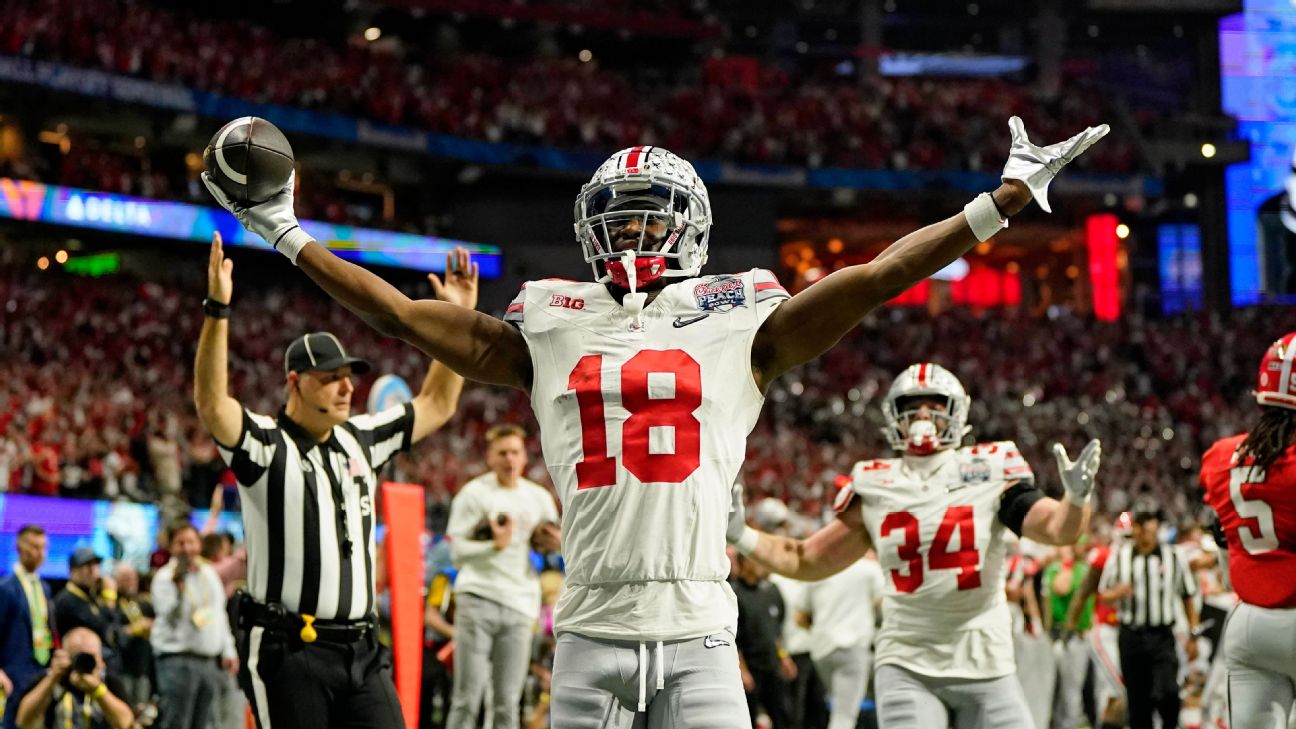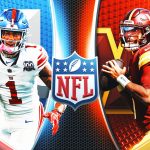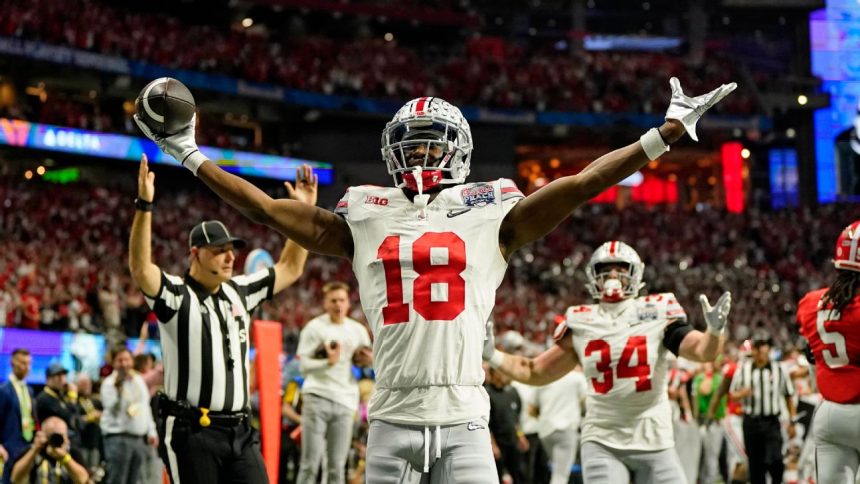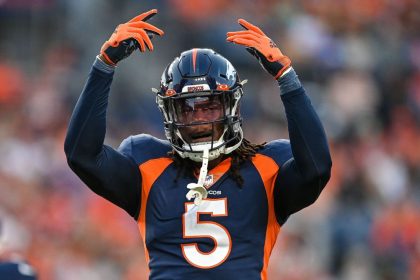
Fantasy football is all about predicting tomorrow, but sometimes it’s fun to look into the distant future.
Ever wonder why we have such things as dynasty and keeper leagues? These formats challenge us to look multiple seasons ahead, helping polish our scouting abilities. It’s an even more accurate method of letting us play virtual GM, planning out rosters for the long haul rather than simply the next several weeks.
With that in mind, let’s have some fun with franchise building in an effort to help those of you in dynasty and keeper leagues. Presenting our All-2026 Team, which attempts to predict the fantasy football leaderboard exactly three seasons from now.
This list is broken down into first and second teams, and players are ranked within their individual positions in the order we project they’ll finish on the 2026 leaderboard. The teams have two quarterbacks, two running backs, three wide receivers, two tight ends and a flex (which can be a quarterback).
Keep in mind this team aims only to identify the game’s very best players three seasons from now, meaning we’ll highlight primarily players with the highest long-term ceilings and those who are likely to still be in the prime of their careers. This should be most helpful for managers seeking to take chances on high-upside players, some of whom might come at relatively low cost in trade today.
(Ages are as of Nov. 1, 2026, or around the midpoint of the 2026 season.)
First Team
 QB1 — Patrick Mahomes (31 years old)
QB1 — Patrick Mahomes (31 years old)
Over the past three seasons, Mahomes has averaged 23.5 fantasy points per game and his game has matured to counter today’s defensive schemes. Yes, Mahomes is still the league’s best at creating outside of structure, with the mobility to add rushing totals off scramble attempts. In fact, Mahomes has rushed for at least 300 yards in each of the past three seasons, in addition to the 116 touchdown passes he has logged during that stretch. But he’s also taking the throws that are available, as more defenses are playing split-safety coverage to limit big plays in the pass game. In 2022, Mahomes posted a single-season-record 417.40 fantasy points, breaking his own mark set in 2018 (417.08) despite only 16.8% of his pass attempts traveling more than 15 air yards downfield. The throwing traits are elite here, and Mahomes’ savvy playmaking ability keeps him as our QB1 in 2026, with the scheme-transcendent ability to produce in any offense. — Bowen
 QB2 — Joe Burrow (29)
QB2 — Joe Burrow (29)
The 2019 Heisman Trophy winner and No. 1 overall pick in 2020 has quietly ascended toward the top tier at his position through three NFL seasons. He boosted his fantasy points per game by at least two points in 2021 and 2022 and is one of only five quarterbacks in history to score at least 300 fantasy points in Years 2 and 3. The other four were mobile quarterbacks who accumulated a good chunk of their production with their legs. Burrow is no slouch as a runner, though, delivering a 75-257-5 rushing stat line in 2022, and he has room for growth as a passer. Few quarterbacks offer fantasy managers as stable a skill set. — Cockcroft
 QB3/flex — Jalen Hurts (28)
QB3/flex — Jalen Hurts (28)
Hurts posted breakout numbers in 2022 with a league-best 25.2 fantasy PPG. As both Tristan and I have stressed this summer, mobility at the QB position is a critical factor to getting consistent production in your lineup. Hurts rushed for 13 scores last season and a total of 760 yards on the ground. And his fantasy profile was elevated even more with his developmental jump as a passer, as Hurts threw for 3,701 yards and 22 touchdowns, compared to only six interceptions. Projecting ahead to 2026, Hurts will still be in his prime playing years and the offense in Philly is a perfect match for his dual-threat traits, with an aggressive general manager in Howie Roseman who will surround the quarterback with talent. You can lock in Hurts as a Tier 1 fantasy quarterback. — Bowen
 RB1 — Bijan Robinson (24)
RB1 — Bijan Robinson (24)
Robinson hasn’t played a single down of pro football, but I can’t ignore the versatile traits — or the anticipated volume — that will push the Texas product to the overall RB1 spot by 2026. In college, Robinson averaged 4.1 yards per carry after contact. He can get downhill now, with the north-south juice to shed tacklers at the point of attack. He has home run speed, too. And let’s not forget that Robinson has the pass-catching skills to create matchup conflicts from multiple alignments, as he logged 60 receptions in his college career. He’s a top target for me this summer in mock drafts. Robinson projects as an “offensive playmaker” in an NFL scheme, one that will utilize him as an elite PPR option. — Bowen
 RB2 — Travis Etienne Jr. (27)
RB2 — Travis Etienne Jr. (27)
One of the more underrated running backs in the NFL, Etienne flashed elite speed last season. Per Next Gen Stats, 26% of his rushing attempts were clocked at 15 mph or faster (second in the league). And Etienne was efficient, too, ranking fourth at his position in both yards per rushing attempt (5.1) and yards per target (7.0). As he gains experience, he should become one of the game’s best dual-threat running backs, and there’s little chance he’ll be as unlucky in the touchdown department as he was in 2022. Etienne’s Jaguars are trending up, with their multiyear competitive window only just beginning, and he’s a big reason. — Cockcroft
 WR1 — Justin Jefferson (27)
WR1 — Justin Jefferson (27)
Jefferson is the only player from the All-2025 Team to repeat as the No. 1 player at his position. He is already renowned for his game-changing talent, and he’ll be in his prime come 2026. He and Jerry Rice are the only wide receivers in history to score at least 310 PPR fantasy points twice in their first three NFL seasons. Jefferson’s 973.26 career points are the second most by any wide receiver through his first 50 games since the merger (1970). Imagine if this guy gets better, and he probably will. — Cockcroft
 WR2 — Marvin Harrison Jr. (24)
WR2 — Marvin Harrison Jr. (24)
Going into his junior year at Ohio State, Harrison already displays the pro-ready traits to make an immediate splash once he enters the league as a volume target with big-play chops. Last season in Columbus, Harrison caught 77 passes (16.4 YPC) to go with 14 touchdowns and 20 explosive-play receptions (20 or more yards). He’s a refined route-runner who can separate at all three levels of the field, using his top-end speed and physical play style to make himself available to the quarterback. Harrison can win vertically or work the underneath areas of the field, with the catch-and-run ability to tack on yardage. And by 2026, we expect him to be a top-five pick in PPR drafts. — Bowen
 WR3 — Ja’Marr Chase (26)
WR3 — Ja’Marr Chase (26)
He took an anticipated step forward as a sophomore, and to exemplify his amazing ability, Chase missed five games last season because of a hairline fracture in his hip yet still managed to finish 11th in fantasy points at his position (and his 20.2 PPG was fourth). He posted a 4.4% catch rate over expected, per Next Gen Stats, and averaged 1.6 yards after the catch more than expected, sixth best among wide receivers. Chase is one of the game’s best at making things happen in the passing game. — Cockcroft
 TE1 — Brock Bowers (23)
TE1 — Brock Bowers (23)
An explosive target in the pass game, the 6-foot-3, 230-pound Bowers posted 17 receptions of 20 yards or more last season for Georgia. He’s a true seam-stretcher who can dice up zone coverage or win one-on-one, and his numbers after the catch (8.3 YAC) should make for an easy transition to a pro offense. Similar to how George Kittle is deployed in San Francisco, pro coaches can get Bowers loose on unders, crossers and tight end screens, plus he gives you the formation flexibility to play as a power slot. I see Bowers as a big-time prospect who can be schemed in the NFL as a volume pass-catcher with the open-field juice to rip off big plays. — Bowen
 TE2 — Kyle Pitts (26)
TE2 — Kyle Pitts (26)
One year ago at this time, Pitts was the class of his position, a bona fide lock to be fantasy’s top tight end for 2024, 2025 and 2026. While the inexplicable downturn in his target total and the MCL surgery that cut his season short in November seem to cast a cloud over his immediate future, I see no reason to doubt Pitts’ long-term raw ability. Even in that miserable 2022, he had a 24% target share (third at his position at the time he got hurt), and averaged 1.85 yards per target (fourth) and 13.5 yards depth of target (easily tops among TEs). That hints at the ton of upside remaining, meaning that right now is the ideal time to buy Pitts. — Cockcroft
Second Team
 QB4 — Justin Herbert (28)
QB4 — Justin Herbert (28)
While Herbert took a step backward in fantasy production in 2022 — he averaged 0.25 points per offensive snap, after averaging 0.34 in 2021 — he remains one of the most reliable quarterbacks. His 994.86 career fantasy points are more than anyone at his position had through three NFL seasons, and he has 26 top-10 scoring weeks in his 49 starts, third most among quarterbacks in that span. Herbert should be in much better shape for a rebound under Kellen Moore this season, putting him back on track for a clear top-five positional valuation come 2026. — Cockcroft
 QB5 — Caleb Williams (24)
QB5 — Caleb Williams (24)
Williams, the 2022 Heisman Trophy winner from USC, makes the cut on our second team. The Mahomes comps are a little rich for me at this point, but the play style does mesh when you turn on his tape. He’s an easy mover, with the natural whip in his arm to attack all three levels of the field. In 2022, Williams threw for 4,537 yards and 42 touchdowns, along with 382 yards rushing. He’s a seamless fit for today’s schemed NFL pass games, complete with play-action and RPO packages. And by 2026, after two years of adapting to pro speed and pro defenses, we see Williams as a top-five fantasy quarterback. — Bowen
 QB6/flex — Trevor Lawrence (27)
QB6/flex — Trevor Lawrence (27)
His sophomore-year jump was one of the most impressive in recent memory, especially coming off the Jaguars’ nightmarish 2021 under Urban Meyer. Lawrence managed top-10 finishes in most every relevant, volume-oriented quarterback statistic, including scoring 295.62 fantasy points (seventh best). He (and his teammates) seemed to catch fire beginning in Week 9, as the Jags won seven of nine games and Lawrence scored 172.12 points in that span (fifth best among QBs). The 2021 No. 1 pick could be on the verge of a major breakthrough. — Cockcroft
 RB3 — Jahmyr Gibbs (24)
RB3 — Jahmyr Gibbs (24)
We like Gibbs here because of dynamic receiving traits and PPR upside. During his college career, Gibbs logged 104 receptions for 1,217 yards and eight scores. The tape shows backfield releases to beat linebackers in coverage, flexed alignments, screens and more. He can scoot in the open field. Plus, Gibbs will see touches as a runner, using his change-of-direction ability to shake down defenders or his perimeter burst to threaten the edges. He’s a dual-threat back who will climb the ranks because of the volume and schemed deployment in a pro pass game. — Bowen
 RB4 — Breece Hall (25)
RB4 — Breece Hall (25)
Hall is a player you shouldn’t give up on just because he’s coming off knee surgery. His short-term fantasy value has dipped, following an ACL reconstruction and his New York Jets signing Dalvin Cook to absorb a good chunk of the rushing chores this season. Nevertheless, Hall showed what he’s capable of before getting hurt. At the time of his injury, his 115.1 fantasy points placed seventh among running backs, fully supported by his top-six average speed and rate of 10-plus-yard runs. I know ACL surgeries can significantly alter running backs’ career trajectories, but I’m optimistic he’ll recover his past form, if not this season then by 2024. — Cockcroft
 WR4 — Garrett Wilson (26)
WR4 — Garrett Wilson (26)
Wilson posted nine games of double-digit PPR production as a rookie in 2022, including three games of 24 or more points. And he did that with lower-tier quarterback play in New York. Wilson has the playmaking traits, plus the sudden stop-and-start ability, to produce after the catch. He can stretch defenses vertically, too, finishing with high-end ball skills and body control. A breakout candidate in 2023 with Aaron Rodgers now in the mix for the Jets, Wilson possesses the skills of a high-ceiling receiver in the NFL, which sets him up to make the jump to WR1 status. — Bowen
 WR5 — CeeDee Lamb (27)
WR5 — CeeDee Lamb (27)
Lamb finished as WR6 last season in PPR scoring and he’ll be right in the middle of his prime playing years at the start of the 2026 season. A receiver with breakout ability (two games of 30 or more points in 2022), Lamb is a fluid route-runner with explosive-play ability and can stress defenses from multiple alignments. We see an ascending talent here who can produce as a Tier 1 wide receiver. — Bowen
 WR6 — Jaylen Waddle (27)
WR6 — Jaylen Waddle (27)
Waddle went from short-range dynamo to a legitimate big-play hero as a sophomore last season, pacing his position in yards per target (11.6 yards) and average yards per catch over expected (2.7). He also finished ninth with 28% of his receptions going for 20-plus yards and saw his average depth of target swell by 5 yards (7.0 to 12.0). Waddle’s production hinged very much on Tua Tagovailoa’s presence in 2022, but the step forward illustrated how this up-and-coming receiver stands on the doorstep of becoming one of the game’s elite talents. — Cockcroft
 TE3 — Dalton Kincaid (27)
TE3 — Dalton Kincaid (27)
At 6-foot-4, 240 pounds, Kincaid is a vertical seam-stretcher who can be deployed as a traditional tight end or flexed to run a wide receiver route tree. In his final season at Utah, he logged 70 receptions for 890 yards and eight touchdowns, and we believe Kincaid can play as a three-level target in an NFL offense. He can work the middle of the field, align as a boundary X receiver and create matchup conflicts for opposing defenses in scoring position. In today’s passing league, Kincaid can be featured as a prime target from multiple formations and alignments, which elevates his overall fantasy profile as a future TE1. — Bowen
 TE4 — T.J. Hockenson (29)
TE4 — T.J. Hockenson (29)
After being traded from Detroit last season, Hockenson played 10 games in Minnesota, posting six games of double-digit PPR production during that stretch, which included a 35.9-point breakout performance in Week 16 versus the Giants. We saw how productive he can be when deployed in a system that caters to his strengths as a receiver. He can work the unders, see the ball inside the red zone and find space between the hashes at the second and third level. Hockenson has the movement ability to separate from coverage and can rumble after the catch, too. He will be on the edge of his prime playing years at the start of the 2026 season, but barring injury, we still see him as a volume target with the receiving ability to produce high-end TE1 numbers. — Bowen
Notable omissions
QB — Josh Allen (30): With Allen into his 30s in this exercise, we had some concerns about the Bills moving on from their QB-centric offense, which would limit his rushing volume on designed carries. — Bowen
QB — Justin Fields (27): It was tough to leave Fields off the list because of his physical tools and playmaking traits as a runner. But we need to see a boost in passing numbers for Fields to climb our QB ranks. — Bowen
RB — Jonathan Taylor (27): From a similar standpoint of forgiving injuries, Taylor would’ve made a lot of sense as one of the game’s elite entering 2026, from both a 2021 production and age perspective. This is a critical year for him recapturing that top-shelf status heading into 2024. — Cockcroft
WR — Jaxon Smith-Njigba (24): The eventual replacement for Tyler Lockett in Seattle, Smith-Njigba is a smooth and controlled route-runner, with the change-of-direction pace to uncover in the NFL. While Smith-Njigba’s totals could be capped early in his career, he projects as primary volume target — with inside/outside flex — as a WR1 with Seattle in 2026. — Bowen
WR — DeVonta Smith (27): Perhaps the most painful player for me to keep beneath the cut, Smith was an extremely reliable, high-floor receiver despite playing second fiddle to A.J. Brown in 2022. Smith is as good a 100-1,000-8 annual threat as the position has going forward. — Cockcroft











